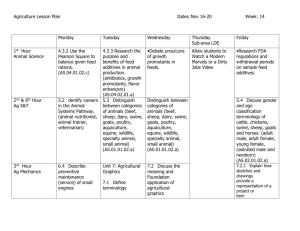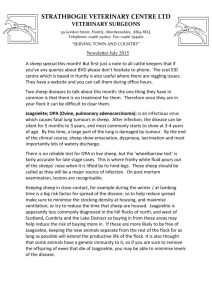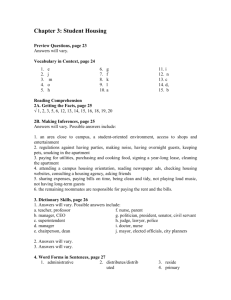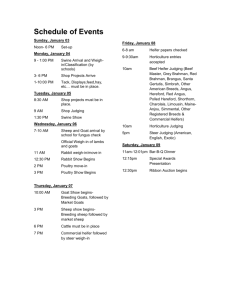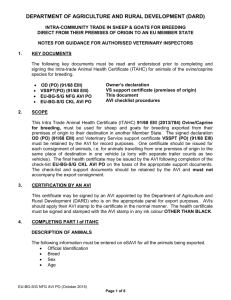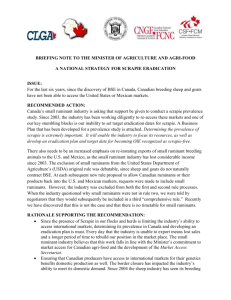Owner`s notes for guidance Word
advertisement
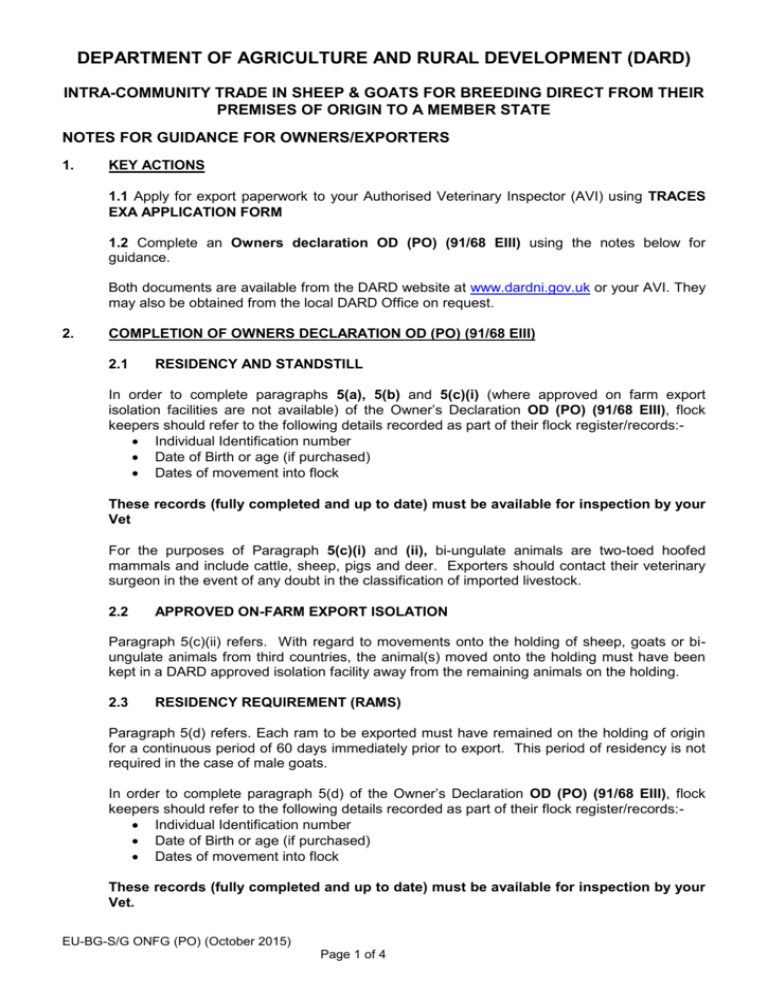
DEPARTMENT OF AGRICULTURE AND RURAL DEVELOPMENT (DARD) INTRA-COMMUNITY TRADE IN SHEEP & GOATS FOR BREEDING DIRECT FROM THEIR PREMISES OF ORIGIN TO A MEMBER STATE NOTES FOR GUIDANCE FOR OWNERS/EXPORTERS 1. KEY ACTIONS 1.1 Apply for export paperwork to your Authorised Veterinary Inspector (AVI) using TRACES EXA APPLICATION FORM 1.2 Complete an Owners declaration OD (PO) (91/68 EIII) using the notes below for guidance. Both documents are available from the DARD website at www.dardni.gov.uk or your AVI. They may also be obtained from the local DARD Office on request. 2. COMPLETION OF OWNERS DECLARATION OD (PO) (91/68 EIII) 2.1 RESIDENCY AND STANDSTILL In order to complete paragraphs 5(a), 5(b) and 5(c)(i) (where approved on farm export isolation facilities are not available) of the Owner’s Declaration OD (PO) (91/68 EIII), flock keepers should refer to the following details recorded as part of their flock register/records: Individual Identification number Date of Birth or age (if purchased) Dates of movement into flock These records (fully completed and up to date) must be available for inspection by your Vet For the purposes of Paragraph 5(c)(i) and (ii), bi-ungulate animals are two-toed hoofed mammals and include cattle, sheep, pigs and deer. Exporters should contact their veterinary surgeon in the event of any doubt in the classification of imported livestock. 2.2 APPROVED ON-FARM EXPORT ISOLATION Paragraph 5(c)(ii) refers. With regard to movements onto the holding of sheep, goats or biungulate animals from third countries, the animal(s) moved onto the holding must have been kept in a DARD approved isolation facility away from the remaining animals on the holding. 2.3 RESIDENCY REQUIREMENT (RAMS) Paragraph 5(d) refers. Each ram to be exported must have remained on the holding of origin for a continuous period of 60 days immediately prior to export. This period of residency is not required in the case of male goats. In order to complete paragraph 5(d) of the Owner’s Declaration OD (PO) (91/68 EIII), flock keepers should refer to the following details recorded as part of their flock register/records: Individual Identification number Date of Birth or age (if purchased) Dates of movement into flock These records (fully completed and up to date) must be available for inspection by your Vet. EU-BG-S/G ONFG (PO) (October 2015) Page 1 of 4 2.4 HEALTH STATUS Paragraph 5(e) refers. The sheep/goats to be exported must not come from holdings where the listed diseases have been clinically diagnosed within the specified time periods. If any of the sheep for export have come into contact with sheep or goats from holdings where disease has occurred within the specified time periods, those animals are disqualified from export but this does not disqualify any other sheep or goats on the same holding which comply with the requirement of Paragraph 5(e). 2.5 SCRAPIE REQUIREMENTS 2.5.1 Paragraph 5(f)(i) refers. In order to be able to export, the flock/herd of origin must be registered under the DARD Scrapie Monitored Flock Scheme (SMFS), or in the case of sheep be of genotype ARR/ARR. 2.5.2 Paragraph 5(f)(iii) refers. Veterinary checks can take the form of visits by Departmental officials or your private Vet. 2.5.3 Paragraph 5(f)(v) refers. Cull females and fallen animals (over the age of 18 months) from the flock/herd must be submitted for TSE (Scrapie) testing, in accordance with the rules of the SMFS. 2.5.4 Paragraph 5(f)(vii) refers. The return of any animals from shows/sales other than those described could affect the status of the holding of origin. If this has occurred, the local DVO should be consulted. 2.5.5 Paragraph 5(f)(viii) refers. Where only part of your flock is registered in the Scrapie Monitored Flocks Scheme, only animals kept in the monitored part of the flock and recorded in your Scrapie Monitored Register are eligible for intra community trade (unless they are sheep of ARR/ARR genotype –see 2.5.6 below). 2.5.6 Paragraph 5(g) refers: From 1 October 2003, sheep of the ARR/ARR prion protein genotype may be certified for intra-Community trade (except to Sweden, Finland and Denmark) regardless of the scrapie status of the holding of birth or holding(s) of subsequent residence; Sweden, Finland and Denmark have been given additional guarantees. To be ARR/ARR genotyped, the blood sample for testing must have been taken: a) by a Private Veterinary Practitioner as part of the Northern Ireland Scrapie Plan (NISP) or the National Scrapie Plan (NSP) in Great Britain; OR b) by a Private Veterinary Practitioner and tested by the Animal and Plant Health Agency (APHA), the Scottish Agricultural College (SAC); OR c) by a Private Veterinary Practitioner and tested at any officially approved EU laboratory with ISO17025 accreditation. You must provide a certificate, produced under any of the above schemes, to confirm the ARR/ARR genotype. Please note, any certificates produced using option (c) above must state that a Veterinarian took the blood sample and include the name and address of the Veterinarian. 2.6 TRANSPORT Paragraph 5(h) refers. Suitable transport arrangements must have been made to ensure that the requirements of this paragraph are complied with. 3. PRE EXPORT TESTING OF RAMS EU-BG-S/G ONFG (PO) (October 2015) Page 2 of 4 Blood samples must be taken from all rams within 30 days of consignment and sent to the Veterinary Sciences Division for testing using the complement fixation test for Brucella ovis. A negative result is less than 50 icftu/ml. This test is not required in the case of male goats. 4. OFFICIAL IDENTIFICATION OF SHEEP AND GOATS INTENDED FOR EXPORT Sheep leaving any premises in Northern Ireland must be individually identified with two matching identifiers (usually tags), one of which must carry an EID device. This identification meets the requirements for export to GB or EU member states. Identification must comply with the requirements of The Sheep and Goats (Records, Identification and Movement) Order (NI) 2009. Goats born or first tagged after 31st Dec 2009 for export to EU Member States including the Republic of Ireland must be individually identified with 2 matching identifiers (usually tags) one of which must carry an EID device. Goats born or first tagged before 31st Dec 2009 for export to EU Member States including the Republic of Ireland must be individually identified with 2 matching identifiers (usually tags) one of which may carry an EID device. Identification must comply with the requirements of The Sheep and Goats (Records, Identification and Movement) Order (NI) 2009. 5. WELFARE Council Regulation 1/2005 lays down the provisions for the protection of animals during transport. The Regulation is enforced in Northern Ireland by the Welfare of Animals (Transport) Regulations (NI) 2006. Article 3 of the EU Regulation requires that animals must be fit for the intended journey before the journey starts and must remain sufficiently fit throughout the journey and that no person shall transport them in a way likely to cause injury or undue suffering. This means that animals should be healthy enough to tolerate the entire journey they are about to make (including loading, unloading and any journey breaks) with no or very little adverse effect on them and that the journey should not cause the animals any suffering or injury. Animals not considered to be fit for transport include those that: d) are unable to move independently without pain or to walk unassisted; present a severe open wound, or prolapse; are pregnant females for whom 90% or more of the expected gestation period has already passed, or females who have given birth in the previous week; mammals in which the navel has not completely healed; are lambs less than one week of age, unless they are transported less than 100 km. The certifying AVI will reject any animal where, in his or her professional judgement, there is doubt over its fitness on the intended journey. 6. TRANSPORTER AUTHORISATION AND VEHICLE CERTIFICATION Articles 10 and 11 of Council Regulation 1/2005 require transporters of animals to be authorised, and Article 18 requires that the vehicle or trailer used to transport animals on long journeys has a certificate of approval. For journeys over 65km (approx. 40 miles), transporters must: Hold a transporter authorisation. If transporting farmed animals, ensure drivers and attendants are in possession of a certificate of competence (from January 2008). Demonstrate they have appropriate staff and equipment to transport animals in a proper way and to have no record of serious infringements of animal welfare legislation in the preceding 3 years. EU-BG-S/G ONFG (PO) (October 2015) Page 3 of 4 Complete an Animal Transport Certificate for each journey. For long journeys (over 8 hours) transporters must also: Be in possession of a long journey transporter authorisation. If the vehicle is used for transporting farmed animals and horses, get it inspected and approved. Ensure contingency plans in case of emergencies are in place. Ensure the Journey Log has been completed (for journeys of unregistered horses and livestock). 7. CANCELLATION OR CHANGES TO THE CONSIGNMENT DETAILS FOLLOWING CERTIFICATION If the consignment is • cancelled, or • its date/time of departure has changed significantly, or • a different vehicle is used, or • all the animals are not loaded, the owner must notify the certifying Vet giving the relevant details so that a replacement TRACES message can be sent. EU-BG-S/G ONFG (PO) (October 2015) Page 4 of 4

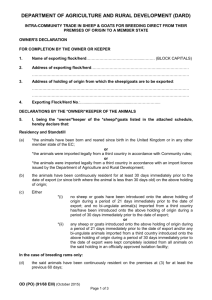
![Teeswater Sheep Breeders` Association Me[...]](http://s3.studylib.net/store/data/007144755_1-44ce9acb9fb5e8e8a9fd22b9cf356606-300x300.png)
